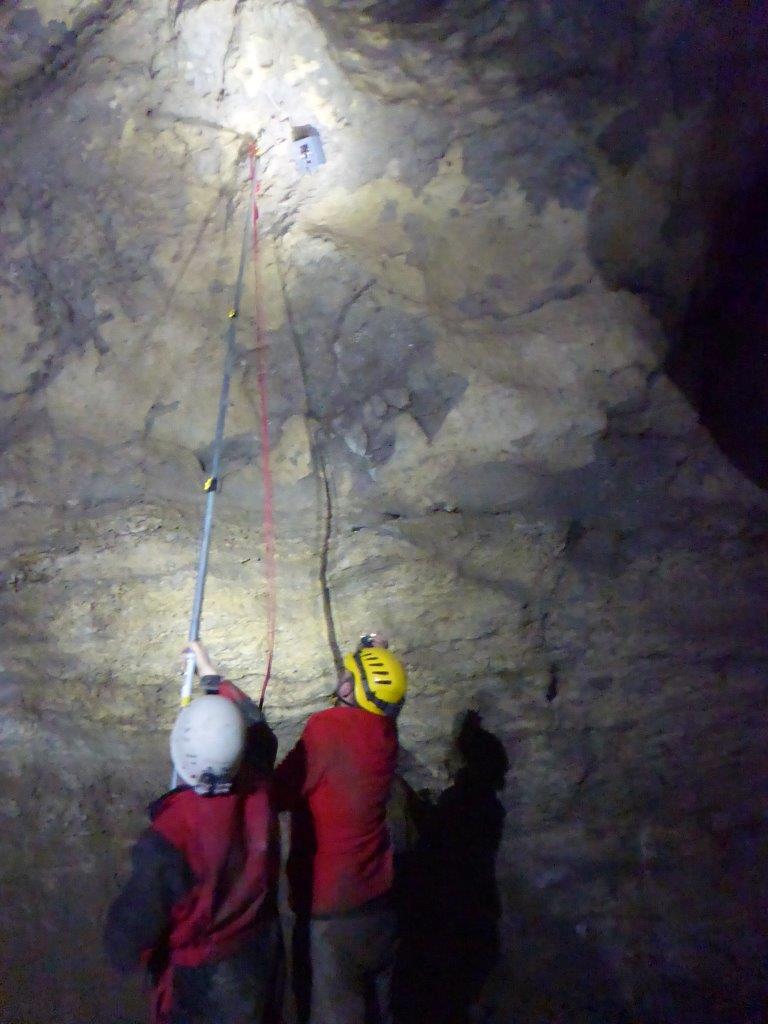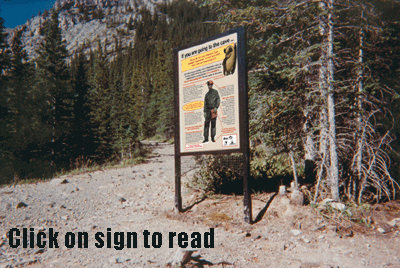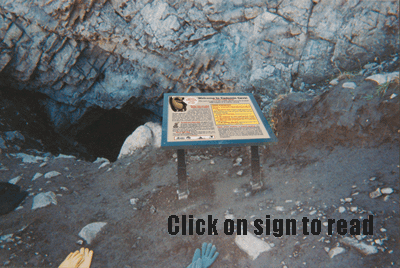Conservation & Restoration
-
Cadomin Cave
![]()
Hibernating Bats in Cadomin Cave
Although it was once one of the most visited caves in Alberta, Cadomin Cave near Hinton has been closed by Provincial Government Ministerial Order since 2010. This closure order was extended for a further 5 years in 2015. These orders were imposed due to the significant geographic progression of white-nose syndrome (WNS) in bats, in an attempt to prevent the spread of WNS to this important bat hibernaculum. Even before the 2010 total closure, access was not allowed between the September long weekend (Labor Day) until May 1st, to protect the bat colony during its fall/winter hibernation season.
History
No one knows who discovered Cadomin Cave, but it had probably been known to local natives for centuries. It is thought to have been visited by prospectors early in the 1900s, and people have been visiting it ever since. The cave is named after the nearby village of Cadomin, which comes from the acronym for Canada Dominion Mining. Exaggerated rumors of the extent of Cadomin Cave abound. It is even said that in the old days, miners used to ride through the cave on horseback all the way to Miette Hotsprings, some thirty kilometres away as the crow flies, just to take a dip! Although the truth is somewhat more modest, Cadomin Cave has long been popular with outdoorsmen keen on a little different type of adventure.
The first known survey of the cave was performed in 1959 by WL Biggs and RS Taylor, who produced a fairly accurate map. When the Alberta Speleological Society was formed in 1968, Cadomin Cave was one of only a few caves known in Alberta, and had already been heavily vandalized. The Alberta Speleological Society commenced a thorough exploration, resurvey and documentation of the cave’s extent, while at the same time organizing several cleanup trips to collect litter and remove spray-painted graffiti in an effort to keep the cave presentable for other visitors.
![]()
Biologist Retrieving Roost Logger
There have been several attempts to establish guiding services for Cadomin Cave, and even a few proposals for development and commercialization. Concurrent with this has been growing interest from Alberta Environment, Fish and Wildlife, the University of Alberta and other bodies interested in the natural history of the cave and its population of bats. The Alberta Speleological Society became official stewards of Cadomin Cave under Alberta Environment’s volunteer stewardship program in 1997, and conducted graffiti removal and garbage collection, participated on several ‘bat counts’, and assisted the Alberta government with management planning for the cave and surrounding area. With the creation of Whitehorse Wildlands Provincial Park in 1999, Cadomin Cave and its bat population received legal protection.
A program of limited trail development and signage was put in place, to assist the public with safe and responsible visits to the cave. Although the original signage was rendered irrelevant to this specific cave due to the 2010 closure order, it contains a concise and useful review of good caving practices in any cave.
Today Cadomin Cave still bears the scars of years of overuse by humans. Virtually no cave formations remain; all is brown and muddy. However its large passages continue to house an important bat hibernaculum, which we hope will remain healthy.
-
Conservation and Restoration
Caver's Motto: Take nothing but pictures. Leave nothing but footprints. Kill nothing but time.
The Alberta Speleological Society passionately supports conservative low impact caving. The ecosystem and many physical features within caves are extremely delicate. It is our job as responsible cavers to ensure that we always follow the caver's motto. We support the values and activities of organizations dedicated to cave conservation such as the Canadian Cave Conservancy.
Take Nothing But Pictures
Never remove anything from the cave. This includes removing cave formations even if they have been broken or damaged, animal bones or any other naturally occurring parts of the cave ecosystem. Speleothems such as stalactites may have taken many thousands of years to grow and are useless as souvenirs; they simply crumble away after being removed from the high-humidity environment of the cave.
Leave Nothing But Footprints
Take everything that you brought into the cave with you when you leave. If you find garbage left by a careless cavers please take it out of the cave as well. A cave ecosystem helpful hint: eat your lunch over a plastic bag to avoid dropping crumbs. Anytime you see a patch of odd looking mold on the cave trail then you know someone likely ate lunch there in the past! It should go without saying, but it is extremely bad form to leave either liquid or solid human waste in a cave; it persists for a very long time, as the cave ennvironment does not have the natural cleaning processes that occur on the surface. Try to void before entering a cave; for longer trips experienced cavers take empty plastic sacks / bottles and pack it out.
Kill Nothing But Time
The cave ecosystem is more diverse than most people realize. Along with bats, pack rats and other animals that call the cave entrance home there may also be some smaller life forms (e.g. troglodytic isopods in water) and a huge array of microorganisms that can be found in the soil, water and on cave formations. Disturbing a bat hibernacula or a maternity colony can be devastating to the bats that live there. Stepping in an isolated pool of water inside the cave can introduce foreign bacteria to the pool which can completely wipe out unique life that has evolved in the pool over many thousands of years.
Every step you take has an impact. Stay on established trails, touch as little as possible and leave the passages in the same way that you found them. We all need to do our part to protect the beautiful and largely forgotten chambers hidden below the ground.
The Alberta Speleological Society is actively involved in local cave restoration projects. As government - appointed stewards of Cadomin Cave the Alberta Speleological Society has historically organized periodic restoration events, focused on removing trash and graffiti from this formerly - accessible cave. Cadomin Cave was closed to the public in 2009 due to a disease called White Nose Syndrome, that has been devastating colonies of hibernating bats across eastern Canada and the US. Since the fungus responsible for White Nose Syndrome could possibly be transferred from an affected cave to a non-affected cave on cavers clothing or gear; it is very important that we all follow WNS decontamination protocols and respect any closures such as the one in place for Cadomin.
The Rats Nest Cave restoration project is an ongoing effort to repair the impact that cavers have had on this popular cave. The Alberta Speleological Society volunteers are using a variety of restoration methods to remove mud from formations, limit future damage, create cave conservation awareness and conduct photo monitoring to measure caver impact over time.
-
Cave Manners
Most mountain users try to treat nature with respect, but it is important to recognize that caves are somewhat different from other environments. Caves may appear rather durable, but they are not subject to the same types of erosion and renewal that you have on the surface, and the impacts of visitors may last for a long, long time. Rockies caves are not heavily decorated with speleothems (formations) but they are present in most. Speleothems are extremely fragile and sensitive; don't even touch them. It may take ten thousand years for groundwater to dissolve enough limestone to make a cave and its speletheoms, but people who don’t know better can ruin the place in just one visit. Please do your bit to make the cave cleaner for the next person. Pick up some garbage; gently scrub off some graffiti with cave water (no solvents).
The more remote caves and difficult passages, accessible only to properly equipped and experienced cavers, are generally in near-perfect condition. That's because serious cavers all believe in the same thing:
Leave it as you found it - except for trash, which should be removed.
Like they say, "Take nothing but pictures, leave nothing but footprints". It's not necessary to use spray paint, string or pieces of plastic trail tape to mark your way into an unknown cave. At a passage junction, a caver may make a temporary marker by stacking a couple of stones. They indicate which way is out. As you might imagine, taking home bits of the cave is an absolute no-no. A photo of your group in the cave means much more than a lump of rock, which will crumble away in a couple of years once removed from the high-humidity cave environment. Boosting your ego by leaving your name only offends those who follow.
Bats live in the remote, back portions of many caves. These are mostly the Little Brown species, an important predator of insects such as mosquitoes, but harmless to man. If you are not looking for them, chances are you will not even see them. Please do not disturb or harass the bats, especially in winter when they are hibernating. Bats can carry rabies, so you should never try to touch or pick one up. Make sure all clothing and gear is decontaminated between caves to avoid the spread of White Nose Syndrome.
Snack wrappers and any other trash should go back into your day pack right away; otherwise they're inclined to disappear into the dark - until the next person comes along to be disgusted by them.
Excreting in the cave pollutes the water there and it tends to persist for a long time as the surface processes of decomposition are not present or greatly slowed. If possible, do your thing before going in & use zip lock bags to carry out any solids if you do go inside.



